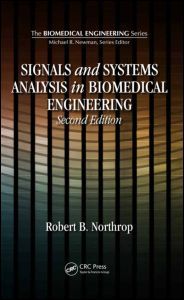Signals and Systems Analysis In Biomedical Engineering (2nd Ed.) Biomedical Engineering Series
Auteur : Northrop Robert B.

The first edition of this text, based on the author?s 30 years of teaching and research on neurosensory systems, helped biomedical engineering students and professionals strengthen their skills in the common network of applied mathematics that ties together the diverse disciplines that comprise this field. Updated and revised to include new material as the field has grown, Signals and Systems Analysis in Biomedical Engineering, Second Edition continues to provide a ready source of information on those specialized mathematical techniques most useful in describing and analyzing biomedical signals.
New chapters on nonlinear and complex systems
Enriched with many examples that promote sound practical analysis, this volume covers classical linear systems theory and its applications to biomedicine. It examines the important use of joint time-frequency analysis to characterize non-stationary physiological signals, and explores the mathematics of tomographic imaging (the Radon transform, the Fourier slice theorem, and the filtered back-projection algorithm). It also describes the analytical signal and the Hilbert transform and some of its biomedical applications. New chapters in this edition include one on the analysis of nonlinear biochemical systems and biochemical oscillators, as well as one introducing complex systems and illustrating ways to best model them.
Four appendices with additional material
Extensive appendices supplement the text, including "Simnon® Programs Used in Chapters 11 and 12," "How to use Root Locus to Determine the Stability of SISO Linear Systems," "Signal Flow Graphs and Mason?s Rule," and "Computational Tools for Biomedical Signal Processing and Systems Analysis." An extensive glossary is included as well as an ample listing of sources for further study.
Introduction to Biomedical Signals and Systems. Review of Linear Systems Theory. The Laplace Transform and Its Applications. Fourier Series Analysis of Periodic Signals. The Continuous Fourier Transform. The Discrete Fourier Transform. Introduction to Joint TimeFrequency Analysis of Biomedical Signals. Introduction to the Analysis of Stationary Noise, and Signals Contaminated with Noise. Basic Mathematical Tools Used in the Characterization of Physiological Systems. Introduction to the Mathematics of Tomographic Imaging. Introduction to the Analysis of Nonlinear Biochemical Systems and Biochemical Oscillators. Introduction to Complex Systems in Biology and Medicine. Glossary. Appendix A. Appendix B. Appendix C. Appendix D. Index.
Robert B. Northrop graduated with a bachelor’s degree in electrical engineering from the Massachusetts Institute of Technology in 1956. At the University of Connecticut (UCONN), he received a master’s degree in systems engineering in 1958. As the result of a long-standing interest in physiology, he entered a PhD program at UCONN in physiology, doing research on the neuromuscular physiology of molluskan catch muscles. He received his PhD in 1964. His current research interest lies in complex systems. Dr. Northrop was on the electrical and computer engineering faculty at UCONN until his retirement in June 1997. Throughout this time, he was director of the BME graduate program. As emeritus professor, he still teaches courses in BME, writes texts, sails, and travels. He lives in Chaplin, CT, with his wife, and a smooth fox terrier.
Date de parution : 03-2010
Ouvrage de 654 p.
15.6x23.4 cm
Thème de Signals and Systems Analysis In Biomedical Engineering :
Mots-clés :
Real Convolution; Low Pass Lter; fourier; LTI System; series; Laplace Transform; discrete; HIV Infection; transform; Loop Gain; laplace; Limit Cycle Oscillations; square; Bode Plot; wave; Frequency Response Function; low; Describing Function Analysis; pass; Odd Nonlinearity; lter; Describing Function Method; Hill Function; Transport Lag; Fourier Series; Sinusoidal Frequency Response; Rt; SNR Improvement; BCOs; Insulin Sensitive Cells; Stable Limit Cycle Oscillations; Morlet Wavelet; Input SNR; Phase Plane Plot; Dierence Equation



